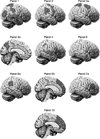Cultural Neuroscience
- PMID: 23874143
- PMCID: PMC3714113
- DOI: 10.1111/j.1467-839X.2010.01301.x
Cultural Neuroscience
Abstract
Cultural neuroscience issues from the apparently incompatible combination of neuroscience and cultural psychology. A brief literature sampling suggests, instead, several preliminary topics that demonstrate proof of possibilities: cultural differences in both lower-level processes (e.g. perception, number representation) and higher-order processes (e.g. inferring others' emotions, contemplating the self) are beginning to shed new light on both culture and cognition. Candidates for future cultural neuroscience research include cultural variations in the default (resting) network, which may be social; regulation and inhibition of feelings, thoughts, and actions; prejudice and dehumanization; and neural signatures of fundamental warmth and competence judgments.
Keywords: culture; emotion; neuroscience; perception; self; social cognition.
Figures

References
-
- Anderson MC, Ochsner KN, Kuhl B, et al. Neural systems underlying the suppression of unwanted memories. Science. 2004;303(5655):232–235. - PubMed
-
- Ansari D. Effects of development and enculturation on number representation in the brain. Nature Reviews Neuroscience. 2008;9(4):278–291. - PubMed
-
- Aslin RN. Experiential influences and sensitive periods in perceptual development: A unified model. In: Aslin RN, Alberts JR, Petersen MR, editors. Development of Perception. Psychobiological Perspectives (Vol. 2): The Visual System. New York: Academic Press; 1981. pp. 45–93.
Grants and funding
LinkOut - more resources
Full Text Sources
